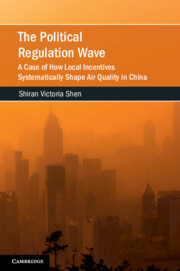Tables
2.1Comparison of sulfur dioxide control under the 10th and the 11th FYPs
3.1Tenure length and political mobility of prefectural party secretaries, 2000–10
3.2Policy targets for different policy areas at the national level, and at the provincial and prefectural levels in Hubei Province in 2006
4.1Summary statistics for observations from nonoverlapping tenures for prefectures that received high reduction targets
4.2Relationship between political tenure and SO2 regulatory stringency under the 10th FYP (2001–5) and the 11th FYP (2006–10)
4.3Relationship between political tenure and SO2 regulatory stringency under the 11th FYP (2006–10)
5.1Relationship between political tenure and satellite-derived PM2.5 concentration, 2000–10
5.2Relationship between political tenure and economic outputs, 2000–10
5.3Relationship between political connection and the strength of the political pollution wave, 2000–10
5.4Relationship between political tenure and PM2.5 concentration, 2013–17
5.5Relationship between political tenure and officially reported GDP and industrial regulatory stringency, 2013–17
5.6Relationship between political connection and the strength of the political regulation wave, 2014–17
6.1Premature deaths due to tenure-induced PM2.5 emissions based on satellite-derived measures in the last year in office
6.2Avoided premature deaths due to tenure-induced PM2.5 emissions based on satellite-derived measures in the last year in office
7.1Relationship between gubernatorial election year and satellite-derived PM2.5 concentration
7.2Relationship between gubernatorial election year and per capita vehicle ownership and per capita electricity consumption
7.3Relationship between gubernatorial election year and public investments and expenditure
7.4Estimated premature deaths due to election-induced PM2.5 emissions based on satellite-derived measures in the gubernatorial election year

